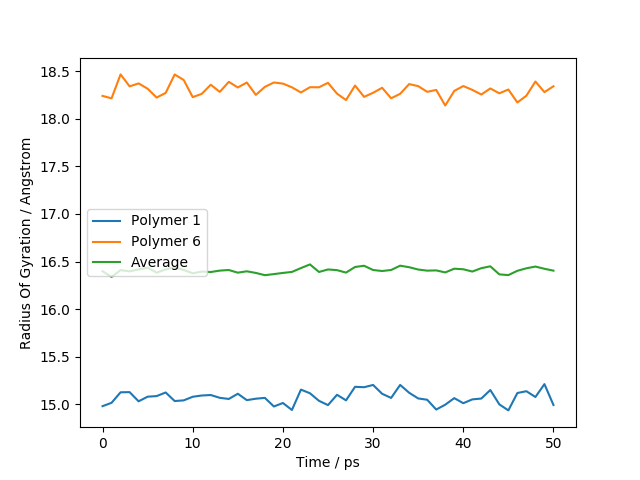RadiusOfGyration¶
- class RadiusOfGyration(md_trajectory, polymer_tags=None, start_time=None, end_time=None, time_resolution=None, mass_weight=None, gui_worker=None)¶
Analyzer to calculate the radius of gyration and shape factors of polymer chains.
- Parameters:
md_trajectory (
MDTrajectory|AtomicConfiguration) – The MDTrajectory or AtomicConfiguration that contains the polymers.polymer_tags (list of type str | None | Automatic) – A list of tags for the polymers. If not specified default tags are used. Tags can also be set automatically with the flag Automatic
start_time (PhysicalQuantity of the type time) – The start time. Default:
0.0 * fs.end_time (PhysicalQuantity of the type time) – The end time. Default: The last time image.
time_resolution (PhysicalQuantity of type time) – The time interval between snapshots in the MD trajectory that are included in the analysis. Default: the MD time step.
mass_weight (bool) – Whether or not masses of atoms are included in the calculations. Default: True.
gui_worker (PolymerAnalysisWorker) – Handle to the worker, for displaying the calculation progress. Default: None.
- acylindricalFactor()¶
- Returns:
The acylindrical factor for each polymer chain. This is returned as a 2D array indexed by trajectory image then polymer chain.
- Return type:
ndarray
- anisotropicFactor()¶
- Returns:
The anisotropic factor for each polymer chain. This is returned as a 2D array indexed by trajectory image then polymer chain.
- Return type:
ndarray
- asphericalFactor()¶
- Returns:
The aspherical factor for each polymer chain. This is returned as a 2D array indexed by trajectory image then polymer chain.
- Return type:
ndarray
- components()¶
- Returns:
The components of the radius of gyration. This is returned as a 3D array indexed by trajectory image, polymer chain, component.
- Return type:
PhysicalQuantity of type length
- polymerTags()¶
Return the polymer tags used for the analysis.
- Returns:
A list of the polymer tags.
- Return type:
list
- radius()¶
- Returns:
The radius of gyration of the polymers. This is returned as a 2D array indexed by trajectory image and then polymer chain.
- Return type:
PhysicalQuantity of type length
- times()¶
- Returns:
Times for each image used in the analysis.
- Return type:
PhysicalQuantityof type time
Usage Examples¶
Calculate the average radius of gyration of polystyrene chains during a molecular dynamics simulation starting from a well equilibrated configuration.
# -------------------------------------------------------------
# Initial Configuration
# -------------------------------------------------------------
bulk_configuration = nlread('Polystyrene.hdf5')[-1]
# -------------------------------------------------------------
# OPLS-AA Calculator
# -------------------------------------------------------------
potential_builder = OPLSPotentialBuilder()
calculator = potential_builder.createCalculator(bulk_configuration)
bulk_configuration.setCalculator(calculator)
# -------------------------------------------------------------
# Molecular Dynamics
# -------------------------------------------------------------
initial_velocity = ConfigurationVelocities(
remove_center_of_mass_momentum=True
)
method = NPTMartynaTobiasKlein(
time_step=1*femtoSecond,
reservoir_temperature=300*Kelvin,
reservoir_pressure=1*bar,
thermostat_timescale=100*femtoSecond,
barostat_timescale=500*femtoSecond,
initial_velocity=initial_velocity,
heating_rate=0*Kelvin/picoSecond,
)
constraints = [FixCenterOfMass()]
md_trajectory = MolecularDynamics(
bulk_configuration,
constraints=constraints,
trajectory_filename='Polystyrene_Trajectory.hdf5',
steps=100000,
log_interval=10,
trajectory_interval=1000,
method=method
)
# -------------------------------------------------------------
# Calculate Radius Of Gyration
# -------------------------------------------------------------
analyzer = RadiusOfGyration(
md_trajectory,
start_time=0*ps,
end_time=50*ps
)
radius_of_gyration = analyzer.radius()
radius_of_gyration_average = radius_of_gyration.mean(axis=1)
time = analyzer.times().convertTo(ps)
# -------------------------------------------------------------
# Plot The Results
# -------------------------------------------------------------
import pylab
pylab.figure()
pylab.plot(time, radius_of_gyration[:, 0], label='Polymer 1')
pylab.plot(time, radius_of_gyration[:, 5], label='Polymer 6')
pylab.plot(time, radius_of_gyration_average, label='Average')
pylab.xlabel('Time / ps')
pylab.ylabel('Radius Of Gyration / Angstrom')
pylab.legend()
pylab.savefig('Radius_Of_Gyration_Plot.png')
RadiusOfGyration_Example.py
Polystyrene.hdf5
The script will run a short molecular dynamics calculation from the given starting structure and then calculate the radius of gyration for two individual polymers, as well as the average. This is shown in the following plot

Notes¶
This class enables the calculation of the radius of gyration and polymer chain shape descriptors
from a MDTrajectory or BulkConfiguration[1]. The radius
of gyration, \(R_g\) can be defined as:
Here \(m_i\) represents the mass of the atoms, \(\mathbf{r}_i\) represents the atomic positions and \(\mathbf{r}_{COM}\) represents the center of mass. As atomic masses are included, \(R_g\) defined here is the mass-weighted radius of gyration. Assuming each atomic mass is equivalent, produces the unweighted radius of gyration. The radius of gyration gives a measure of the overall size of the polymer chain.
Details about the shape can also be calculated. The principal components of the radius of gyration can be found by diagonalizing the gyration tensor. This gives three components \(\lambda_x\), \(\lambda_y\) and \(\lambda_z\) such that:
These components of the radius of gyration can give further information about the overall shape of the polymer chain. The asphericity of a polymer chain \(b\) measures the distance of the chain from a spherically symmetric shape, and is given as:
Similarly the acylindricity of the polymer chain \(c\) measures the deviation of the chain from a cylindrical shape. This can be defined as:
Finally, the anisotropy of the polymer chain \(\kappa^2\) measures the amount to which the shape of the polymer is orientated is a particular direction. This can be defined as:
To calculate each of these shape measures a RadiusOfGyration object first needs to be
created. This takes a MDTrajectory or BulkConfiguration and calculates each of
the size and shape measures for the specified configurations. The specific frames in the
MDTrajectory to be analyzed can be selected using the start_time, end_time and
time_resolution arguments. Whether or not mass weighting is used can be selected with the
mass_weight argument. By default, mass weighting is used when calculating the radius of
gyration. The polymer chains analyzed in the configuration can be specified with the
polymer_tags argument. This takes a list of tags of polymer molecules in the configuration. By
default polymers tagged with POLYMER_MOLECULE_# are analyzed, where # is a numerical index.
These tags are added automatically to polymer configurations built with the
PolymerMonteCarloBuilder, or can be added using the function
tagPolymerMolecules()
Once the RadiusOfGyration object is created and the values of each of the descriptors has
been calculated, the values can be queried using the remaining methods. Each of these returns
arrays of values indexed first by the trajectory frame, then by the polymer. Averaging over all
frames can be done by averaging over axis 0, while averaging over polymer chains is achieved by
averaging over axis 1.
